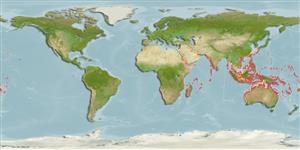Common names from other countries
Environment: milieu / climate zone / depth range / distribution range
экология
морской ассоциированный с рифами; пределы глубины 0 - 80 m (Ref. 9773). Tropical; 32°N - 34°S, 27°E - 170°W
Indo-Pacific: East Africa and eastward through northern Australia to Samoa; north to southern Japan. Replaced by closely related Sufflamen albicaudatus in the Red Sea (Ref. 37816).
Size / Вес / Возраст
Maturity: Lm ? range ? - ? cm
Max length : 30.0 cm TL самец/пол неопределен; (Ref. 30573)
колючие лучи спинного плавника (общее число) : 3; членистые (мягкие) лучи спинного плавника (общее число) : 26 - 28; колючие лучи анального плавника: 0; членистые (мягкие) лучи анального плавника: 23 - 26. Juveniles dark brown above, white below (Ref. 1602). Adult variable in color; the bar running through the pectoral base can either be yellow or black, and some individuals may be largely yellowish posteriorly (Ref. 1602).
Inhabit coastal to outer reefs. Habitats from silty lagoons to pristine outer reef walls (Ref. 48637). Occur in shallow lagoon and seaward reefs. Solitary and territorial. Feed on a wide variety of invertebrates. Also taken by drive-in nets (Ref. 9770). Oviparous (Ref. 205). Monogamous (Ref. 52884). Minimum depth reported taken from Ref. 128797.
Life cycle and mating behavior
Maturities | размножение | Spawnings | Egg(s) | Fecundities | личинки
Male defends a defined territory, within which a female resides. On the day prior to spawning, female pushes her snout into the sandy bottom repeatedly and removes small stones and pieces of coral at several sites. Adhesive eggs are deposited on the sandy bottoms or in a small cavity of the reef covered with sand. Female fans the eggs and defends the nest, while male patrols around female (Ref. 8603). Females are territorial, solely tending and guarding the eggs (Ref. 116451). Males exhibit polygyny (Ref. 116451).
Myers, R.F., 1991. Micronesian reef fishes. Second Ed. Coral Graphics, Barrigada, Guam. 298 p. (Ref. 1602)
Статус Красного Списка МСОП (Ref. 130435)
CITES (Ref. 128078)
Not Evaluated
Угроза для людей
Harmless
Использование человеком
рыболовство: не имеет хозяйственного значения; аквариум: коммерческий
дополнительная информация
инструменты
Специальные отчеты
Скачать в формате XML
ресурсы в Интернет
Estimates based on models
Preferred temperature (Ref.
115969): 24.8 - 29.3, mean 28.4 (based on 3050 cells).
Phylogenetic diversity index (Ref.
82804): PD
50 = 0.5312 [Uniqueness, from 0.5 = low to 2.0 = high].
Bayesian length-weight: a=0.02042 (0.01188 - 0.03509), b=2.94 (2.79 - 3.09), in cm Total Length, based on LWR estimates for this species & (Sub)family-body (Ref.
93245).
Trophic level (Ref.
69278): 3.8 ±0.20 se; based on food items.
устойчивость к внешним воздействиям (Ref.
120179): средний (среднего размера), минимальное время удвоения популяции 1.4-4.4 года (Preliminary K or Fecundity.).
Fishing Vulnerability (Ref.
59153): Low vulnerability (20 of 100).
